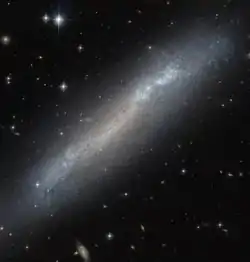| NGC 2188 | |
|---|---|
 Hubble Space Telescope (HST) image of the galaxy | |
| Observation data (J2000 epoch) | |
| Constellation | Columba |
| Right ascension | 06h 10m 09.5s[1] |
| Declination | −34° 06′ 22″[1] |
| Redshift | 0.002492 ± 0.000013 |
| Heliocentric radial velocity | 747 ± 4 km/s[1] |
| Distance | 23.9 ± 10 Mly (7.3 ± 3.1 Mpc)[1] |
| Apparent magnitude (V) | 11.5[2] |
| Characteristics | |
| Type | SB(s)m [1] |
| Apparent size (V) | 4.4′ × 1.1′[1] |
| Other designations | |
| ESO 364-G037, AM 0608-340, MCG -06-14-008, PGC 18536[1] | |
NGC 2188 is a barred spiral galaxy in the constellation Columba. It is located at a distance of circa 25 million light years from Earth, which means that the galaxy, given its apparent dimensions is about 50.000 light years long. It was discovered by John Herschel on January 9, 1836.[3]
NGC 2188 is a spiral galaxy seen edge-on from the viewpoint of Earth as the centre and spiral arms of the galaxy are tilted away from us, with only the very narrow outer edge of the galaxy's disc visible to us. The true shape of the galaxy was identified by studying the distribution of the stars in the inner central bulge and outer disc and by observing the stars' colours.[4] The galaxy is close enough that its stars can be resolved. The brightest of them have an apparent magnitude of about 21.[5]
When imaged in HI, the galaxy appears asymmetrical, maybe due to a recent interaction.[6] The hydrogen gas is more abundant in one end of the galaxy and extends over 4 kpc away from the galactic plane. Other features visible are some filaments and a superbubble with a diameter of 15 arcseconds.[7] The filaments have been associated with a HII region located in the galactic halo.[8] The total hydrogen mass of the galaxy is estimated to be 3×108 M☉,[7] while it is of low metallicity.[8]
NGC 2188 has been found to have three smaller companions, HIPASS J0607-34, ESO364-029, and KK 55.[9]
References
- 1 2 3 4 5 6 7 "NASA/IPAC Extragalactic Database". Results for NGC 2188. Retrieved 2020-11-03.
- ↑ "Revised NGC Data for NGC 2188". spider.seds.org. Retrieved 25 November 2018.
- ↑ Seligman, Courtney. "NGC 2188 (= PGC 18536)". Celestial Atlas. Retrieved 19 November 2018.
- ↑ "A Tilted Wonder". www.spacetelescope.org. 31 August 2020. Retrieved 11 November 2020.
- ↑ Sandage, A., Bedke, J. (1994), The Carnegie Atlas of Galaxies. Volume I, Carnegie Institution of Washington
- ↑ Reeves, S. N.; Sadler, E. M.; Allison, J. R.; Koribalski, B. S.; Curran, S. J.; Pracy, M. B.; Phillips, C. J.; Bignall, H. E.; Reynolds, C. (11 April 2016). "H i emission and absorption in nearby, gas-rich galaxies – II. Sample completion and detection of intervening absorption in NGC 5156". Monthly Notices of the Royal Astronomical Society. 457 (3): 2613–2641. arXiv:1601.03753. doi:10.1093/mnras/stv3011.
- 1 2 Domgoergen, H.; Dahlem, M.; Dettmar, R.-J. (1 September 1996). "What perturbs NGC2188?". Astronomy and Astrophysics. 313: 96–100. arXiv:astro-ph/9608083. Bibcode:1996A&A...313...96D.
- 1 2 Domgoergen, H.; Dettmar, R.-J. (1 June 1997). "On the ionization of the diffuse ionized gas: spectroscopy of NGC 2188". Astronomy and Astrophysics. 322: 391–399. Bibcode:1997A&A...322..391D.
- ↑ Karachentsev, Igor D.; Kaisina, Elena I.; Makarov, Dmitry I. (3 December 2013). "Suites of dwarfs around nearby giant galaxies". The Astronomical Journal. 147 (1): 13. arXiv:1310.6838. Bibcode:2014AJ....147...13K. doi:10.1088/0004-6256/147/1/13. S2CID 119245124.
External links
 Media related to NGC 2188 at Wikimedia Commons
Media related to NGC 2188 at Wikimedia Commons- NGC 2188 on WikiSky: DSS2, SDSS, GALEX, IRAS, Hydrogen α, X-Ray, Astrophoto, Sky Map, Articles and images